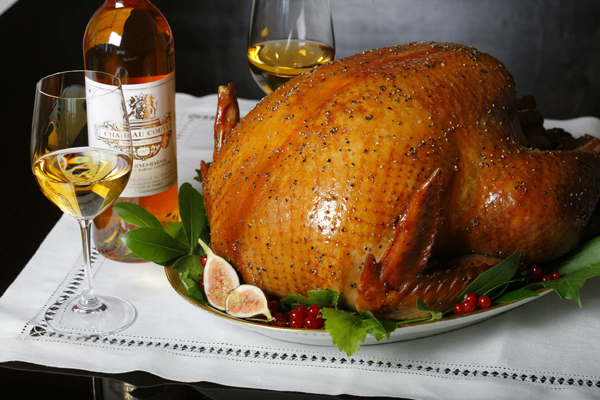
For the past few years, I have tried various alternatives to turkey for my Thanksgiving dinner. It’s not that I don’t like turkey, but I don’t love it, and love should be part of Thanksgiving.
Once, I roasted a loin of pork, decorating it with a paper turkey head and tail. Another year I served lobster on the theory that any food consumed by the Pilgrims was fair game for Thanksgiving. I’ve made Peconic Bay scallops, too, as a turkey substitute. Notice how a scallop shell looks like a turkey’s array of feathers?
No matter what I serve as an entrée, as a wine writer I’m always faced with writing about wines that go well with turkey. Honestly, the topic frustrates me. Turkey is an ambiguous beast, with both dark and light meat, so it’s hard to match. Better to pair the wine with the style of gravy (cabernet franc with giblets; chardonnay with cream gravy), or the stuffing (pinot noir with sausage or mushrooms; sauvignon blanc with oysters and cornbread).
Truth be told, some wines really are better with turkey than others, but Thanksgiving is a celebration, not a wine class, so you might as well drink whatever you like.
For winemakers, Thanksgiving usually marks, not just the end of harvest, but also the end (or almost the end) of fermentation and pressing. On Long Island, we usually have a hard frost in the second or third week of November. Once the leaves are off the vines, the grapes can’t ripen any more; even the latest-ripening varieties like cabernet sauvignon will have to be brought into the cellar.
White grapes are usually harvested before the reds, sometime in September or October, and are pressed as soon as they are picked. That means the winemakers are up late at night pressing out the fruit that came in during the day. The white wines ferment in closed containers for a few weeks and need to be monitored, racked and cold stabilized.
When the reds come in, they are simply crushed, then fermented on their skins for one to three weeks. They must be pumped over or punched down several times a day so that the skins, which float to the top under pressure of carbon dioxide released by yeast, don’t overheat, killing the yeast. Right about the time the winemaking team is exhausted from all this work, the reds need to be pumped into presses and moved to tanks or barrels. Pressing is slow, often dangerous work. Pumps inevitably fail; hoses burst; augurs jam up. November is often fraught with the major and minor disasters.
Winemaking has much in common with childbirth: it follows months of anxious anticipation; it causes pain and fatigue; once it’s over there is little to be done to alter the result (except for upbringing, which may be why the French refer to what happens to wine after fermentation as “élévage”). There may be post-partum depression. But as every new parent and every winemaking community knows, the overriding expression at the end must be joy. Hide any disappointments; it’s time to celebrate and give thanks.
Ask a winemaker what he or she plans to drink for Thanksgiving, it will probably start with beer.
During harvest, the saying goes, “It takes a lot of beer to make good wine,” and many of the late nights throughout harvest have been fuelled by beer, soda or water, not wine—and certainly not booze. Once the food comes out, there may be a special bottle from an old vintage that has been kept to share with friends.
Vineyard managers get to take it easy a couple of weeks before Thanksgiving. Once the fruit is safely in the cellar, bird nets are tidied up and equipment cleaned. Preparations are under way for winter’s pruning, which may begin as soon as leaves are off the vines, though in this climate it’s better to wait until the vines are fully dormant in January. Once the sap retreats into the roots, there is less risk for plant diseases to be spread through pruning cuts.
Some of the growers I know like to take this pause between harvest and pruning to do a little fishing or hunting. People who work outside all year tend to want to stay there, even when it’s cold. Autumn on Long Island may lack the brilliant colors of New England, but the lowering light is still gorgeous. Taking a rest from the year’s labor, the vintner strolls through the vines, towards the woods ... Hey! What’s that? A wild turkey?